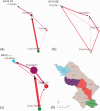Evolution and phylogeographic dissemination of endemic porcine picornaviruses in Vietnam
- PMID: 27774295
- PMCID: PMC4989877
- DOI: 10.1093/ve/vew001
Evolution and phylogeographic dissemination of endemic porcine picornaviruses in Vietnam
Abstract
Members of the Picornaviridae are important and often zoonotic viruses responsible for a variety of human and animal diseases. However, the evolution and spatial dissemination of different picornaviruses circulating in domestic animals are not well studied. We examined the rate of evolution and time of origin of porcine enterovirus G (EV-G) and porcine kobuvirus species C lineages (PKV-C) circulating in pig farms in Vietnam and from other countries. We further explored the spatiotemporal spread of EV-G and PKV-C in Southwest Vietnam using phylogeographic models. Multiple types of EV-G are co-circulating in Vietnam. The two dominant EV-G types among isolates from Vietnam (G1 and G6) showed strong phylogenetic clustering. Three clades of PKV-C (PKV-C1-3) represent more recent introductions into Vietnam; PKV-C2 is closely related to PKV-C from Southwest China, indicating possible cross-border dissemination. In addition, high virus lineage migration rates were estimated within four districts in Dong Thap province in Vietnam for both EV-G types (G1, G6) and all PKV-C (C1-3) clades. We found that Chau Thanh district is a primary source of both EV-G and PKV-C clades, consistent with extensive pig trading in and out of the district. Understanding the evolution and spatial dissemination of endemic picornaviruses in pigs may inform future strategies for the surveillance and control of picornaviruses.
Keywords: enterovirus; evolution; kobuvirus; phylogeography; porcine picornavirus.
Figures




Similar articles
-
Evolutionary Origin, Genetic Recombination, and Phylogeography of Porcine Kobuvirus.Viruses. 2023 Jan 14;15(1):240. doi: 10.3390/v15010240. Viruses. 2023. PMID: 36680281 Free PMC article.
-
A Quadruplex RT-qPCR for the Detection of Porcine Sapelovirus, Porcine Kobuvirus, Porcine Teschovirus, and Porcine Enterovirus G.Animals (Basel). 2025 Mar 31;15(7):1008. doi: 10.3390/ani15071008. Animals (Basel). 2025. PMID: 40218401 Free PMC article.
-
Large-scale screening and characterization of enteroviruses and kobuviruses infecting pigs in Vietnam.J Gen Virol. 2016 Feb;97(2):378-388. doi: 10.1099/jgv.0.000366. Epub 2015 Dec 9. J Gen Virol. 2016. PMID: 26653281 Free PMC article.
-
A Systematic Review: Is Porcine Kobuvirus Causing Gastrointestinal Disease in Young Pigs?Vet Sci. 2023 Apr 11;10(4):286. doi: 10.3390/vetsci10040286. Vet Sci. 2023. PMID: 37104441 Free PMC article. Review.
-
Avian picornaviruses: molecular evolution, genome diversity and unusual genome features of a rapidly expanding group of viruses in birds.Infect Genet Evol. 2014 Dec;28:151-66. doi: 10.1016/j.meegid.2014.09.027. Epub 2014 Sep 30. Infect Genet Evol. 2014. PMID: 25278047 Review.
Cited by
-
Evolutionary Origin, Genetic Recombination, and Phylogeography of Porcine Kobuvirus.Viruses. 2023 Jan 14;15(1):240. doi: 10.3390/v15010240. Viruses. 2023. PMID: 36680281 Free PMC article.
-
Genomic Epidemiology and Evolution of Duck Hepatitis A Virus.Viruses. 2021 Aug 11;13(8):1592. doi: 10.3390/v13081592. Viruses. 2021. PMID: 34452457 Free PMC article.
-
Construction of enterovirus G expressing reporter genes for antiviral drug screening assays.BMC Vet Res. 2025 Aug 13;21(1):515. doi: 10.1186/s12917-025-04960-0. BMC Vet Res. 2025. PMID: 40804379 Free PMC article.
-
A panoramic view of the molecular epidemiology, evolution, and cross-species transmission of rosaviruses.Vet Res. 2024 Nov 8;55(1):145. doi: 10.1186/s13567-024-01399-3. Vet Res. 2024. PMID: 39516900 Free PMC article.
-
No Exchange of Picornaviruses in Vietnam between Humans and Animals in a High-Risk Cohort with Close Contact despite High Prevalence and Diversity.Viruses. 2021 Aug 27;13(9):1709. doi: 10.3390/v13091709. Viruses. 2021. PMID: 34578290 Free PMC article.
References
-
- Cho Y. Y., et al. (2015) ‘Molecular Evolution of Kobuviruses in Cats’, Archives of Virology, 160: 537–41. - PubMed
Grants and funding
LinkOut - more resources
Full Text Sources
Other Literature Sources
Research Materials
Miscellaneous

